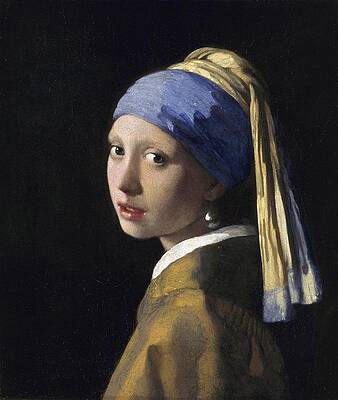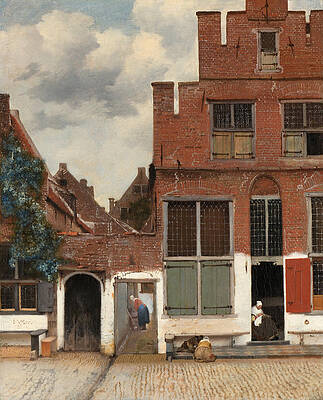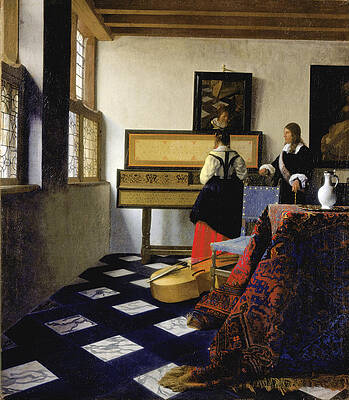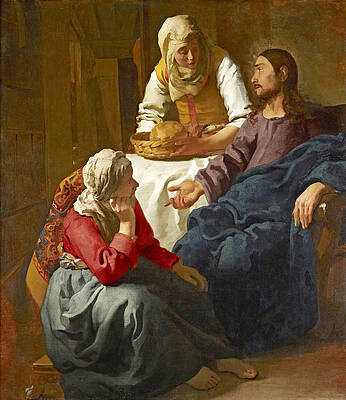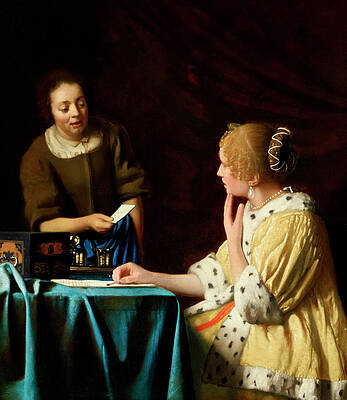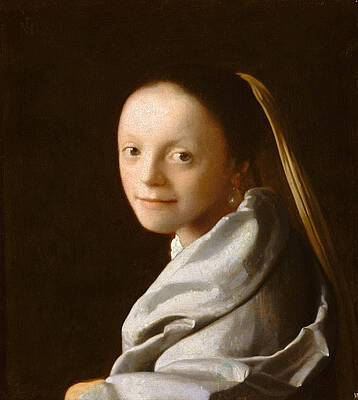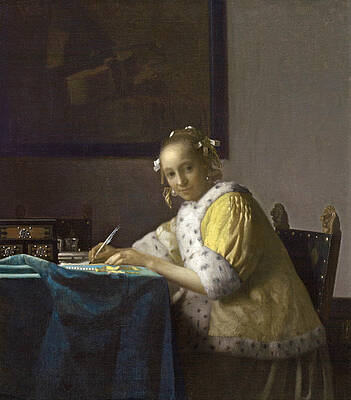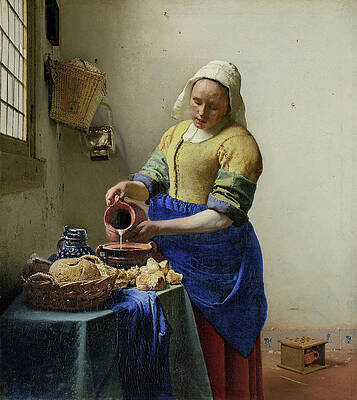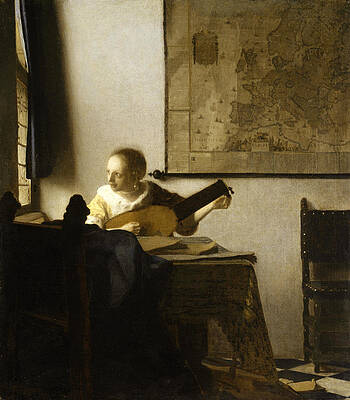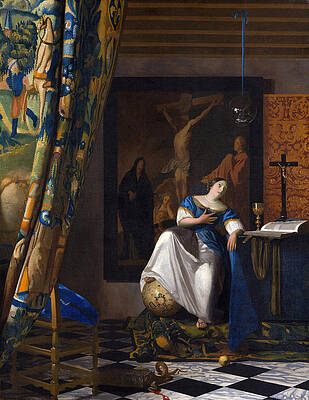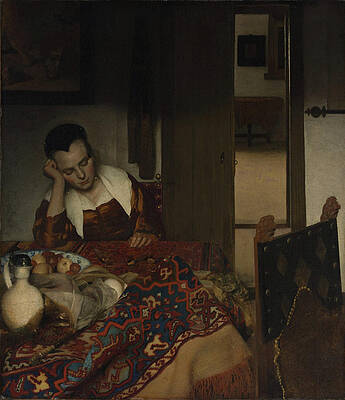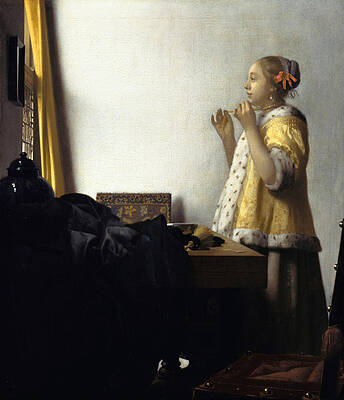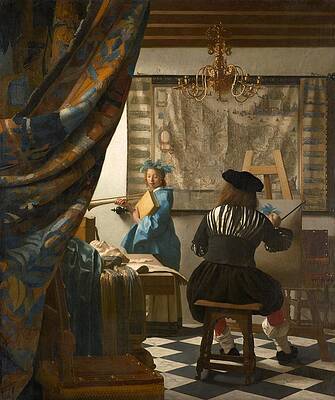Jan Vermeer van Delft
Paintings
Girl with a Pearl Earring
View of Houses in Delft known as The little Street
Lady at the Virginal with a Gentleman . The Music Lesson
Christ in the House of Martha and Mary
Mistress and Maid
Officer and Laughing Girl
Portrait of a Young Woman
A Lady Writing
The Milkmaid
Woman with a Lute near a Window
The Geographer
The Glass of Wine
The Allegory of the Faith
A Maid asleep
Young Woman with a Pearl Necklace
The Art of Painting
Allegory of the Catholic Faith
Young Woman with a Water Pitcher
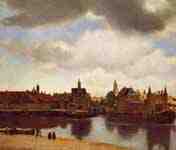

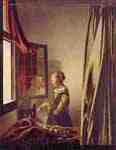
Girl Reading a Letter at an Open Window
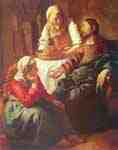
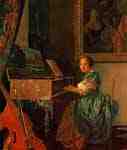
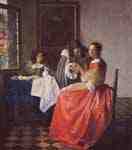
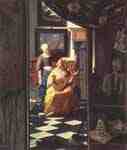
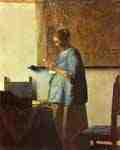
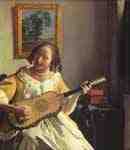
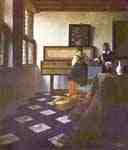
The Music Lesson or gentleman and lady at the spinet
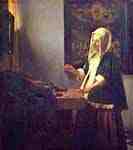
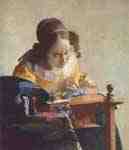
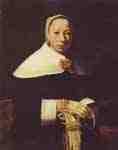

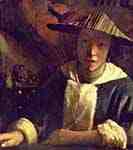
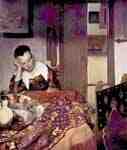
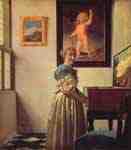
Fine Art Prints | Greeting Cards | Phone Cases | Lifestyle | Face Masks | Men's , Women' Apparel | Home Decor | jigsaw puzzles | Notebooks | Tapestries | ...
Girl with a Pearl Earring
Johannes, Jan or Johan Vermeer (/vərˈmɪər/;[3] Dutch: [joːˈɦɑnəs jɑn vərˈmeːr]; 1632 – December 1675) was a Dutch painter who specialized in domestic interior scenes of middle-class life. Vermeer was a moderately successful provincial genre painter in his lifetime. He seems never to have been particularly wealthy, leaving his wife and children in debt at his death, perhaps because he produced relatively few paintings.[4]
Vermeer worked slowly and with great care, using bright colours and sometimes expensive pigments, with a preference for lapis lazuli and Indian yellow. He is particularly renowned for his masterly treatment and use of light in his work.[5]
Vermeer painted mostly domestic interior scenes. "Almost all his paintings are apparently set in two smallish rooms in his house in Delft; they show the same furniture and decorations in various arrangements and they often portray the same people, mostly women."[6]
Recognized during his lifetime in Delft and The Hague, his modest celebrity gave way to obscurity after his death; he was barely mentioned in Arnold Houbraken's major source book on 17th-century Dutch painting (Grand Theatre of Dutch Painters and Women Artists), and was thus omitted from subsequent surveys of Dutch art for nearly two centuries.[7][8] In the 19th century, Vermeer was rediscovered by Gustav Friedrich Waagen and Théophile Thoré-Bürger, who published an essay attributing 66 pictures to him, although only 34 paintings are universally attributed to him today.[2] Since that time, Vermeer's reputation has grown, and he is now acknowledged as one of the greatest painters of the Dutch Golden Age.
Life
A row of houses on the market in Delft, with the inn Mechelen, but made circa 1730 by Leonard Schenk after a drawing by Abraham Rademaker
For a long time, relatively little was known about Vermeer's life.[9] He seems to have been devoted exclusively to his art, living out his life in the city of Delft. Until the 19th century, the only sources of information were some registers, a few official documents and comments by other artists; it was for this reason that Thoré-Bürger named him "The Sphinx of Delft".[10] John Michael Montias added a lot of details on the family from the city archives of Delft, in his Artists and Artisans in Delft: A Socio-Economic Study of the Seventeenth Century (1982).
Youth
On 31 October 1632, Johannes was baptized in the Reformed Church.[11][12][Note 1] His father, Reijnier Janszoon, was a middle-class worker of silk or caffa (a mixture of silk and cotton or wool).[Note 2] As an apprentice in Amsterdam, Reijnier lived on fashionable Sint Antoniesbreestraat, then a street with many resident painters. In 1615, he married Digna Baltus. The couple moved to Delft and had a daughter, Geertruy, who was baptized in 1620.[Note 3] In 1625, Reijnier was involved in a fight with a soldier named Willem van Bylandt, who died from his wounds five months later.[13] Around this time, Reijnier began dealing in paintings. In 1631, he leased an inn, which he called "The Flying Fox". In 1635 he lived on Voldersgracht 25 or 26. In 1641, he bought a larger inn on the market square, named after the Flemish town "Mechelen". The acquisition of the inn constituted a considerable financial burden.[Huerta 1] When Vermeer's father died in October 1652, Vermeer assumed operation of the family's art business.
Marriage and family
The Jesuit Church on the Oude Langendijk in Delft. 1700-1725. Brush in gray ink. 13.2 × 20.2 cm. Delft, Archief Delft.
In April 1653, Johannes Reijniersz Vermeer married a Catholic girl, Catharina Bolenes (Bolnes). The blessing took place in a quiet nearby village, Schipluiden. For the groom it was a good match. His mother-in-law, Maria Thins, was significantly wealthier than he, and it was probably she who insisted Vermeer convert to Catholicism before the marriage on 5 April.[Note 4] According to the art historian Walter Liedtke, Vermeer's conversion seems to have been made with conviction.[14] One of his paintings, The Allegory of Faith,[15] made between 1670 and 1672, placed less emphasis on the artists’ usual naturalistic concerns, and more on religious symbolic applications, including the sacrament of the Eucharist. Walter Liedtke in Dutch Paintings in the Metropolitan Museum of Art suggests it was made for a learned and devout Catholic patron, perhaps for his schuilkerk, or "hidden church."[Liedtke 1] At some point, the couple moved in with Catharina's mother, who lived in a rather spacious house at Oude Langendijk, almost next to a hidden Jesuit church.[Note 5] Here Vermeer lived for the rest of his life, producing paintings in the front room on the second floor. His wife gave birth to 15 children, four of whom were buried before being baptized, but were registered as "child of Johan Vermeer".[Montias 1] From wills written by relatives, the names of 10 of Vermeer's children are known: Maria, Elisabeth, Cornelia, Aleydis, Beatrix, Johannes, Gertruyd, Franciscus, Catharina, and Ignatius.[Montias 2] Several of these names carry a religious connotation, and it is likely that the youngest, Ignatius, was named after the founder of the Jesuit order.[Note 6][Note 7]
Career
Replica of the St.Luke Guildhouse on Voldersgracht in Delft.
The Little Street (1657–58)
View of Delft (1660–61) "He took a turbulent reality, and made it look like Heaven on earth."[16]
The Geographer by Johannes Vermeer.
It is unclear where and to whom Vermeer was apprenticed as a painter. Speculation that Carel Fabritius may have been his teacher is based upon a controversial interpretation of a text written in 1668 by the printer Arnold Bon. Art historians have found no hard evidence to support this.[Montias 3] The local authority, Leonaert Bramer, acted as a friend, but their style of painting is rather different.[17] Liedtke suggests Vermeer taught himself, using information from one of his father's connections.[Liedtke 2] Some scholars think Vermeer was trained under the Catholic painter Abraham Bloemaert. Vermeer's style is similar to that of some of the Utrecht Carravagists, whose works are depicted as paintings-within-paintings in the backgrounds of several of his compositions.[Note 8]
On 29 December 1653, Vermeer became a member of the Guild of Saint Luke, a trade association for painters. The guild's records make clear that Vermeer did not pay the usual admission fee. It was a year of plague, war and economic crisis; Vermeer was not alone in experiencing difficult financial circumstances. In 1654, the city suffered the terrible explosion known as the Delft Thunderclap, which destroyed a large section of the city.[18] In 1657, he might have found a patron in the local art collector Pieter van Ruijven, who lent him some money. It seems Vermeer turned for inspiration to the art of the "fijnschilders" from Leiden. Vermeer was responding to the market of Gerard Dou's paintings, who sold his paintings all over for exorbitant prices. Dou may have influenced Pieter de Hooch and Gabriel Metsu too. The influence of Johannes Vermeer on Metsu, the light from the left, the marble floor, are unmistakable,[19][20][21] though, according A. Waiboer, Metsu requires more emotional involvement of the viewer. Vermeer probably competed also with Nicolaes Maes, who produced genre works in a similar style. In 1662, Vermeer was elected head of the guild and was reelected in 1663, 1670, and 1671, evidence that he (like Bramer) was considered an established craftsman among his peers. Vermeer worked slowly, probably producing three paintings a year, and on order. When Balthasar de Monconys visited him in 1663 to see some of his work, Vermeer had no paintings to show. The diplomat and the two French clergymen who accompanied him were sent to Hendrick van Buyten, a baker, who had a couple of his paintings as collateral.
In 1671, Gerrit van Uylenburgh organised the auction of Gerrit Reynst's collection and offered 13 paintings and some sculptures to Frederick William, Elector of Brandenburg. Frederick accused them of being counterfeits and had sent 12 back on the advice of Hendrick Fromantiou.[22] Van Uylenburg then organized a counter-assessment, asking a total of 35 painters to pronounce on their authenticity, including Jan Lievens, Melchior de Hondecoeter, Gerbrand van den Eeckhout and Johannes Vermeer.
In 1672, a severe economic downturn (the "Year of Disaster") struck the Netherlands, after Louis XIV and a French army invaded the Dutch Republic from the south (known as the Franco-Dutch War). During the Third Anglo-Dutch War, an English fleet and two allied German bishops attacked the country from the east, causing more destruction. Many people panicked; courts, theaters, shops and schools were closed. Five years passed before circumstances improved. In 1674 Vermeer was listed as a member of the civic guards.[23] In the summer of 1675, Vermeer borrowed 1,000 guilders in Amsterdam from Jacob Romboutsz, an Amsterdam silk trader, using his mother-in-law's property as a surety.[24][25] In December 1675, Vermeer died after a short illness. In a petition to her creditors his wife later described his death as follows:
...during the ruinous war with France he not only was unable to sell any of his art but also, to his great detriment, was left sitting with the paintings of other masters that he was dealing in. As a result and owing to the great burden of his children having no means of his own, he lapsed into such decay and decadence, which he had so taken to heart that, as if he had fallen into a frenzy, in a day and a half he went from being healthy to being dead.[26]
He was buried in the Protestant Old Church on 15 December 1675.[Note 9][Note 10] Catharina Bolnes attributed her husband's death to the stress of financial pressures. The collapse of the art market damaged Vermeer's business as both a painter and an art dealer. She, having to raise 11 children, asked the High Court to relieve her of debts owed to Vermeer's creditors.[Montias 1] The Dutch microscopist Antonie van Leeuwenhoek, who worked for the city council as a surveyor, was appointed trustee.[27] The house, with eight rooms on the first floor, was filled with paintings, drawings, clothes, chairs, and beds. In his atelier, there were two chairs, two painter's easels, three palettes, 10 canvases, a desk, an oak pull table, a small wooden cupboard with drawers and "rummage not worthy being itemized".[Montias 4] Nineteen of Vermeer's paintings were bequeathed to Catharina and her mother. The widow sold two more paintings to Hendrick van Buyten in order to pay off a substantial debt.[28]
Vermeer had been a respected artist in Delft, but almost unknown outside his home town. The fact that a local patron, Pieter van Ruijven, purchased much of his output reduced the possibility of his fame spreading.[Note 11] Several factors contributed to his limited oeuvre. Vermeer never had any pupils and therefore there was no school of Vermeer. His family obligations with so many children may have taken up much of his time, as would acting as both an art-dealer and inn-keeper in running the family businesses. His time spent serving as head of the guild and his extraordinary precision as a painter may have also limited his output.
Style
Vermeer may have first executed his paintings tonally, like most painters of his time, using either monochrome shades of grey ("grisaille"), or a limited palette of browns and greys ("dead coloring"), over which more saturated colors (reds, yellows and blues) were applied in the form of transparent glazes. No drawings have been positively attributed to Vermeer, and his paintings offer few clues to preparatory methods.
There is no other 17th-century artist who early in his career employed, in the most lavish way, the exorbitantly expensive pigment lapis lazuli, or natural ultramarine. Vermeer not only used this in elements that are naturally of this colour; the earth colours umber and ochre should be understood as warm light within a painting's strongly-lit interior, which reflects its multiple colours onto the wall. In this way, he created a world more perfect than any he had witnessed.[Liedtke 3] This working method most probably was inspired by Vermeer’s understanding of Leonardo’s observations that the surface of every object partakes of the colour of the adjacent object.[29] This means that no object is ever seen entirely in its natural colour.
A comparable but even more remarkable, yet effectual, use of natural ultramarine is in The Girl with a Wineglass. The shadows of the red satin dress are underpainted in natural ultramarine,[30] and, owing to this underlying blue paint layer, the red lake and vermilion mixture applied over it acquires a slightly purple, cool and crisp appearance that is most powerful.
Even after Vermeer’s supposed financial breakdown following the so-called rampjaar (year of disaster) in 1672, he continued to employ natural ultramarine generously, such as in Lady Seated at a Virginal. This could suggest that Vermeer was supplied with materials by a collector, and would coincide with John Michael Montias’ theory that Pieter van Ruijven was Vermeer’s patron.
Vermeer's works are largely genre pieces and portraits, with the exception of two cityscapes and two allegories. His subjects offer a cross-section of seventeenth-century Dutch society, ranging from the portrayal of a simple milkmaid at work, to the luxury and splendour of rich notables and merchantmen in their roomy houses. Besides these subjects, religious, poetical, musical, and scientific comments can also be found in his work.
Theories of mechanical aid
Vermeer's painting techniques have long been a source of debate, given their almost photorealistic attention to detail, despite Vermeer having had no formal training, and despite only limited evidence that Vermeer had created any preparatory sketches or traces for his paintings.
In 2001, British artist David Hockney published the book Secret Knowledge: Rediscovering the Lost Techniques of the Old Masters, in which he argued that Vermeer – among other Renaissance artists including Hans Holbein and Diego Velázquez – used optics, and specifically some combination of curved mirrors, camera obscura and camera lucida, to achieve precise positioning in their compositions. This became known as the Hockney–Falco thesis, named after Hockney and Charles M. Falco, another proponent of the theory.
Working independently, in 2001 British architecture professor Philip Steadman published the book Vermeer's Camera: Uncovering the Truth behind the Masterpieces, which specifically claimed that Vermeer had used a camera obscura to create his paintings. Noting that many of Vermeer's paintings had been painted in the same room, Steadman found six of his paintings that are precisely the right size if they had been painted from inside a camera obscura in the room's back wall.[31]
Supporters of these theories have pointed to evidence in some of Vermeer's paintings, such as the often-discussed sparkling pearly highlights in Vermeer's paintings, which they argue are the result of the primitive lens of a camera obscura producing halation. It was also postulated that a camera obscura was the mechanical cause of the "exaggerated" perspective seen in Lady at the Virginals with a Gentleman (London, Royal Collection).
In 2008, American entrepreneur and inventor Tim Jenison developed the theory that Vermeer had used a camera obscura along with a "comparator mirror", which is similar in concept to a camera lucida but much simpler, and allows for easily matching color values. He later modified the theory to simply involve a concave mirror and a comparator mirror. He spent the next five years testing his theory by attempting to re-create The Music Lesson himself using these tools, a process captured in the 2013 documentary film Tim's Vermeer.[32]
Several points were brought out by Jenison in support of this technique: First was Vermeer's hyper-accurate rendition of light falloff along the wall. Another was the addition of several highlights and outlines consistent with matching the effects of chromatic aberration, particularly noticeable in primitive optics. Last, and perhaps most telling, is a noticeable curvature in the original painting's rendition of the scrollwork on the harpsichord. This effect, caused by exactly duplicating the view as seen from a curved mirror, matched Jenison's technique precisely.
This theory remains disputed. Aside from the accurately observed mirror reflection above the lady at the virginals, there is no historical evidence regarding Vermeer's interest in optics. The detailed inventory of the artist's belongings drawn up after his death does not include a camera obscura or any similar device.[33]
Works
See also: List of paintings by Johannes Vermeer and Category:Johannes Vermeer
Only three paintings are dated: The Procuress (1656; Gemäldegalerie, Dresden); The Astronomer (1668; Musée du Louvre, Paris); and The Geographer (1669; Städelsches Kunstinstitut, Frankfurt).
Vermeer's mother-in-law, Maria Thins, owned Dirck van Baburen's 1622 oil-on-canvas Procuress (or a copy of it), which appears in the background of two of Vermeer's paintings. The same subject was also painted by Vermeer. After creating his own The Procuress, almost all of Vermeer's paintings are of contemporary subjects in a smaller format, with a cooler palette dominated by blues, yellows and grays. Practically all of his surviving works belong to this period; usually domestic interiors with one or two figures lit by a window on the left. They are characterized by a serene sense of compositional balance and spatial order, unified by a pearly light. Mundane domestic or recreational activities become thereby imbued with a poetic timelessness (e.g. Girl Reading a Letter at an Open Window, Dresden, Gemäldegalerie). Vermeer's two townscapes, View of Delft (The Hague, Mauritshuis) and A street in Delft (Amsterdam, Rijksmuseum), have also been attributed to this period.
A few of his paintings show a certain hardening of manner and are generally thought to represent his late works. From this period come The Allegory of Faith (c. 1670; Metropolitan Museum of Art, New York) and The Love Letter (c 1670; Rijksmuseum, Amsterdam).
Rediscovery and legacy
Vermeer's Art of Painting or The Allegory of Painting (c. 1666-68)
For two centuries after Vermeer's death, his works were appreciated by a number of connoisseurs in the Netherlands—although attributed in many cases to better-known artists such as Metsu or Mieris—but were largely overlooked by art historians. The Delft master's modern rediscovery began about 1860, when the German museum director Gustav Waagen saw The Art of Painting in the Czernin gallery in Vienna, and recognized as a Vermeer the work which was at that time attributed to Pieter de Hooch.[34] Research by Théophile Thoré-Bürger culminated in the publication in 1866 of his catalogue raisonné of Vermeer's works in the Gazette des Beaux-Arts.[35] Thoré-Bürger's catalogue, which drew international attention to Vermeer,[36] listed more than 70 works by Vermeer, including many he regarded as uncertain.[35] The accepted number of Vermeer's paintings today is 34.
Upon the rediscovery of Vermeer's work, several prominent Dutch artists, including Simon Duiker, modelled their style on his work. Other artists who were inspired by Vermeer include the Danish painter Wilhelm Hammershoi[37] and the American Thomas Wilmer Dewing.[38] In the 20th century, Vermeer's admirers included Salvador Dalí, who painted his own version of The Lacemaker and pitted large copies of the original against a rhinoceros in some now-famous surrealist experiments. Dali also immortalized the Dutch Master in The Ghost of Vermeer of Delft Which Can Be Used As a Table, 1934.
Han van Meegeren was a 20th-century Dutch painter who worked in the classical tradition. Motivated by a blend of aesthetic and financial reasons, van Meegeren became a master forger, creating and selling many new "Vermeers" before being caught and tried.[39]
References in other media
In the first volume of Marcel Proust's novel In Search of Lost Time, entitled Swann's Way, the protagonist Charles Swann is said to be working on an extended essay concerning Vermeer's art. In addition, Vermeer's View of Delft features in a pivotal sequence of a later volume, The Captive, in the same work.
A Vermeer painting plays a key part of the dénouement in Agatha Christie's After the Funeral (1953). Susan Vreeland's novel Girl in Hyacinth Blue follows eight individuals with a relationship to a painting of Vermeer. The young adult novel Chasing Vermeer by Blue Balliett centers around the fictitious theft of Vermeer's A Lady Writing. J. P. Smith's novel, The Discovery of Light, deals largely with Vermeer. The character of Barney in Thomas Harris's novel Hannibal (1999) has a goal to see every Vermeer painting in the world before he dies.
Brian Howell's novel, The Dance of Geometry (Toby Press, 2002), narrates four interlinking episodes that centre around the creation of Vermeer's 'The Music Lesson', dealing with his childhood and courtship of his wife-to-be; a visit by a French traveller who becomes involved in the final stages of the work and its tragic end; a modern copyist's deliberations on the importnace of the work in his life; and the final stages of Vermeer's life.
Tracy Chevalier's novel Girl with a Pearl Earring and the film of the same name (2003) are named after the painting; they present a fictional account of its creation by Vermeer and his relationship with the (equally fictional) model. The film was nominated for Oscars in cinematography, art direction, and costume design.
Peter Greenaway's film A Zed & Two Noughts (1985) contains a plot line about an orthopedic surgeon named Van Meegeren who stages highly exact scenes from Vermeer paintings in order to paint copies of them.
John Jost's film All the Vermeers in New York (1990) makes reference to a woman's resemblance to a Vermeer painting.
The Dutch composer Louis Andriessen based his opera Writing to Vermeer (1997–98, libretto by Peter Greenaway) on the domestic life of Vermeer.
The song "No One Was Like Vermeer" from the 2008 album Because Her Beauty Is Raw and Wild by Boston singer-songwriter Jonathan Richman pays tribute to Vermeer's painstaking technique. Richman also references Vermeer in his song "Vincent Van Gogh" and both songs are frequently part of Richman's live performances.
"Jan Vermeer" is a rockabilly song written by Bob Walkenhorst for his solo album The Beginner. David Olney's song "Mister Vermeer" on his 2010 album Dutchman's Curve imagines Vermeer's unrequited love for the subject of Girl with a Pearl Earring.
Historian Timothy Brook's Vermeer's Hat: The Seventeenth Century and the Dawn of the Global World (2007) examines six of Vermeer's paintings for evidence of world trade and globalization during the Dutch Golden Age.
The 2013 documentary film Tim's Vermeer follows inventor Tim Jenison's examination on his theory that Vermeer used optical devices to assist in generating his realistic images.[40]
Notes
In the 17th century Johannes was a popular name and spelling was not consistent. The name could be spelled in the Dutch (Johan or Johannes), French (Joan), Italian (Giovanni), Greek (Johannis), or other style depending on background, education or family tradition.
His name was Reijnier or Reynier Janszoon, always written in Dutch as Jansz. or Jansz; this was his patronym. As there was another Reijnier Jansz at that time in Delft, it seemed necessary to use the Pseudonym "Vos", meaning Fox. From 1640 onward, he had changed his alias to Vermeer.
In 1647 Geertruy, Vermeer's only sister, married a frame maker. She kept on working at the inn helping her parents, serving drinks and making beds.
Catholicism was not a forbidden religion, but tolerated in the Dutch Republic. They were not allowed to built new churches, so services were held in hidden churches (so-called Schuilkerk). Catholics were restrained in their careers, unable to get high-ranking jobs in city administration, or civic guard. It was impossible to be elected as a member of the city council, and therefor the Catholics were not represented in the provincial and national assembly.
A Roman Catholic chapel now exists at this spot.
As the parish registers of the Delft Catholic church do not exist anymore, it is impossible to prove but likely that his children were baptized in a hidden church.
The number of children seems inconsistent, but 11 was stated by his widow in a document to get help from the city council. One child died after this document was written.
Identifiable works include compositions by Utrecht painters Baburen and Everdingen
He was baptized as Joannis, but buried under the name Jan.
When Catharina Bolnes was buried in 1688, she was registered as the "widow of Johan Vermeer".
Van Ruijven's son-in-law Jacob Dissius owned 21 paintings by Vermeer, listed in his heritage in 1695. These paintings were sold in Amsterdam the following year in a much studied auction, published by Gerard Hoet.
References
"The Procuress: Evidence for a Vermeer Self-Portrait". Retrieved 13 September 2010.
Jonathan Janson, Essential Vermeer: complete Vermeer catalogue; accessed 16 June 2010.
"Vermeer". Random House Webster's Unabridged Dictionary.
"Jan Vermeer". The Bulfinch Guide to Art History. Artchive. Retrieved 21 September 2009.
"An Interview with Jørgen Wadum". Essential Vermeer. 5 February 2003. Retrieved 21 September 2009.
Koningsberger, Hans. 1977. The World of Vermeer, New York: Time-Life Books, p. ?
Barker, Emma et al. (1999). The Changing Status of the Artist. New Haven: Yale University Press. p. 199. ISBN 0-300-07740-8. Retrieved 2012-04-19.
If Vermeer was largely unknown to the general public, his reputation was not totally eclipsed after his death: "While it is true that he did not achieve widespread fame until the 19th century, his work had always been valued and admired by well-informed connoisseurs." Blankert, Albert, et al. Vermeer and his Public, p. 164. New York: Overlook, 2007, ISBN 978-1-58567-979-9
"Vermeer the Man and Painter". Essential Vermeer. Retrieved 10 April 2014.
"Vermeer: A View of Delft". The Economist. 1 April 2001. Retrieved 21 September 2009.
"Vermeer's Name". Essential Vermeer. Retrieved 21 September 2009.
"Digital Family Tree of the Municipal Records Office of the City of Delft". Beheersraad Digitale Stamboom. 2004. Retrieved 21 September 2009. "The painter is recorded as: Child=Joannis; Father=Reijnier Jansz; Mother=Dingnum Balthasars; Witnesses=Pieter Brammer, Jan Heijndricxsz, Maertge Jans; Place=Delft; Date of baptism=31 October 1632."
John Michael Montias (1989). Vermeer and His Milieu: A Web of Social History. Princeton University Press. p. 83.
Liedtke, Walter; Plomp, Michiel C.; Rüger, Axel (2001). Vermeer and the Delft school: [catalogue ... in conjunction with the exhibition "Vermeer and the Delft School" held at The Metropolitan Museum of Art, New York, from 8 March to 27 May 2001, and at The National Gallery, London, from 20 June to 16 September 2001]. New Haven: Yale University Press. p. 359. ISBN 0870999737.
"Johannes Vermeer: Allegory of the Catholic Faith (32.100.18) | Heilbrunn Timeline of Art History | The Metropolitan Museum of Art". Metmuseum.org. 20 July 2012. Retrieved 24 July 2012.
Andrew Graham-Dixon, The Madness of Vermeer, BBC Four.
"Vermeer biography". National Gallery of Art. Retrieved 21 September 2009.
"Delft in Johannes Vermeer's Time", Essential Vermeer. Retrieved 29 September 2009
Adriaan E. Waiboer, Gabriel Metsu (1629–1667): Life and Work, PhD dissertation, New York University, School of Fine Arts, 2007: ProQuest, pp. 225–30.
"Curator in the spotlight: Adriaan E. Waiboer, National Gallery of Ireland, Dublin", Codart, retrieved September 12, 2014.
Susan Stamberg, "Gabriel Metsu: The Dutch Master You Don't Know", Morning Edition, NPR, May 18, 2011.
Montias (1989). Vermeer and His Milieu. p. 207. Retrieved 19 April 2012.
"Vermeer's Delft Today: Schutterij and the Doelen", Essential Vermeer.
Montias (1989), Vermeer and His Milieu, p. 337.
"A Postscript on Vermeer and His Milieu", 13 May 2010.
Quoted from "Vermeer's Life and Art (part four)", Essential Vermeer.
Snyder (2015), pp. 268-71
Montias (1989), Vermeer and His Milieu, p. 217.
B. Broos, A. Blankert, J. Wadum, A. K. Wheelock Jr. (1995) Johannes Vermeer, Waanders Publishers, Zwolle
Gaskell, I., M. Jonker & National Gallery of Art (US) (1998), Vermeer Studies. Washington: National Gallery of Art, p. 157. ISBN 0300075219
Steadman, Philip. "Vermeer and the Camera Obscura". BBC. Archived from the original on 29 November 2010. Retrieved 17 October 2010.
Andersen, Kurt (29 November 2013). "Reverse-Engineering a Genius (Has a Vermeer Mystery Been Solved?)". Vanity Fair. Archived from the original on 30 November 2013.
"Vermeer and the Camera Obscura". Essential Vermeer 2.0. Archived from the original on 25 September 2014. Retrieved 30 July 2014.
Gaskell, Jonker & National Gallery of Art (1998). Vermeer Studies, pp. 19–20.
Gaskell, Jonker & National Gallery of Art (1998). Vermeer Studies, p. 42.
Vermeer, J., F. J. Duparc, A. K. Wheelock, Mauritshuis (Hague, Netherlands), & National Gallery of Art (1995). Johannes Vermeer. Washington: National Gallery of Art, p. 59. ISBN 0300065582
Gunnarsson, Torsten (1998), Nordic Landscape Painting in the Nineteenth Century. Yale University Press, p. 227. ISBN 0300070411
"Interpretive Resource: Artist Biography: Thomas Wilmer Dewing". Artic.edu. Retrieved 10 April 2014.
Anthony Julius (22 June 2008). "The Lying Dutchman". The New York Times. Retrieved 19 April 2012.
"Triangulation 118". Twit.Tv. Retrieved 10 April 2014.
Sources
Liedtke, Walter A. (2007). Dutch Paintings in the Metropolitan Museum of Art. Metropolitan Museum of Art. ISBN 0-300-12028-1.
W. Liedtke, p. 893.
W. Liedtke, p. 866.
W. Liedtke, p. 867.
Montias, John Michael (1991). Vermeer and His Milieu: A Web of Social History (reprint, illustrated ed.). Princeton University Press. ISBN 978-0-691-00289-7.
pp. 344–345.
pp. 370–371.
p. 104.
pp. 339–344.
Huerta, Robert D. (2003). Giants of Delft: Johannes Vermeer and the Natural Philosophers: the Parallel Search for Knowledge During the Age of Discovery. Bucknell University Press. ISBN 978-0-8387-5538-9.
pp. 42–43.
Further reading
Liedtke, Walter (2009). The Milkmaid by Johannes Vermeer. New York: The Metropolitan Museum of Art. ISBN 9781588393449.
Liedtke, Walter A. (2001). Vermeer and the Delft School. Metropolitan Museum of Art. ISBN 9780870999734.
Kreuger, Frederik H. (2007). New Vermeer, Life and Work of Han van Meegeren. Rijswijk: Quantes. pp. 54, 218 and 220 give examples of Van Meegeren fakes that were removed from their museum walls. Pages 220/221 give an example of a non–Van Meegeren fake attributed to him. ISBN 978-90-5959-047-2. Retrieved 21 September 2009.
Schneider, Nobert (1993). Vermeer. Cologne: Benedikt Taschen Verlag. ISBN 3-8228-6377-7.
Sheldon, Libby; Nicola Costaros (February 2006). "Johannes Vermeer’s ‘Young woman seated at a virginal". The Burlington Magazine (vol. CXLVIII ed.) (1235).
Snyder, Laura J. (2015). Eye of the Beholder: Johannes Vermeer, Antoni van Leeuwenhoek, and the Reinvention of Seeing. New York: W. W. Norton. ISBN 978-0-393-07746-9.
Steadman, Philip (2002). Vermeer's Camera, the truth behind the masterpieces. Oxford University Press. ISBN 0-19-280302-6.
Wadum, J. (1998). "Contours of Vermeer". In I. Gaskel and M. Jonker. Vermeer Studies. Studies in the History of Art. Washington/New Haven: Center for Advanced Study in the Visual Arts, Symposium Papers XXXIII. pp. 201–223.
Wheelock, Arthur K., Jr. (1988) [1st. Pub. 1981]. Jan Vermeer. New York: Abrams. ISBN 0-8109-1737-8.
---
Fine Art Prints | Greeting Cards | Phone Cases | Lifestyle | Face Masks | Men's , Women' Apparel | Home Decor | jigsaw puzzles | Notebooks | Tapestries | ...
---
Artist
A - B - C - D - E - F - G - H - I - J - K - L - M -
N - O - P - Q - R - S - T - U - V - W - X - Y - Z
Retrieved from "http://en.wikipedia.org/"
All text is available under the terms of the GNU Free Documentation License


